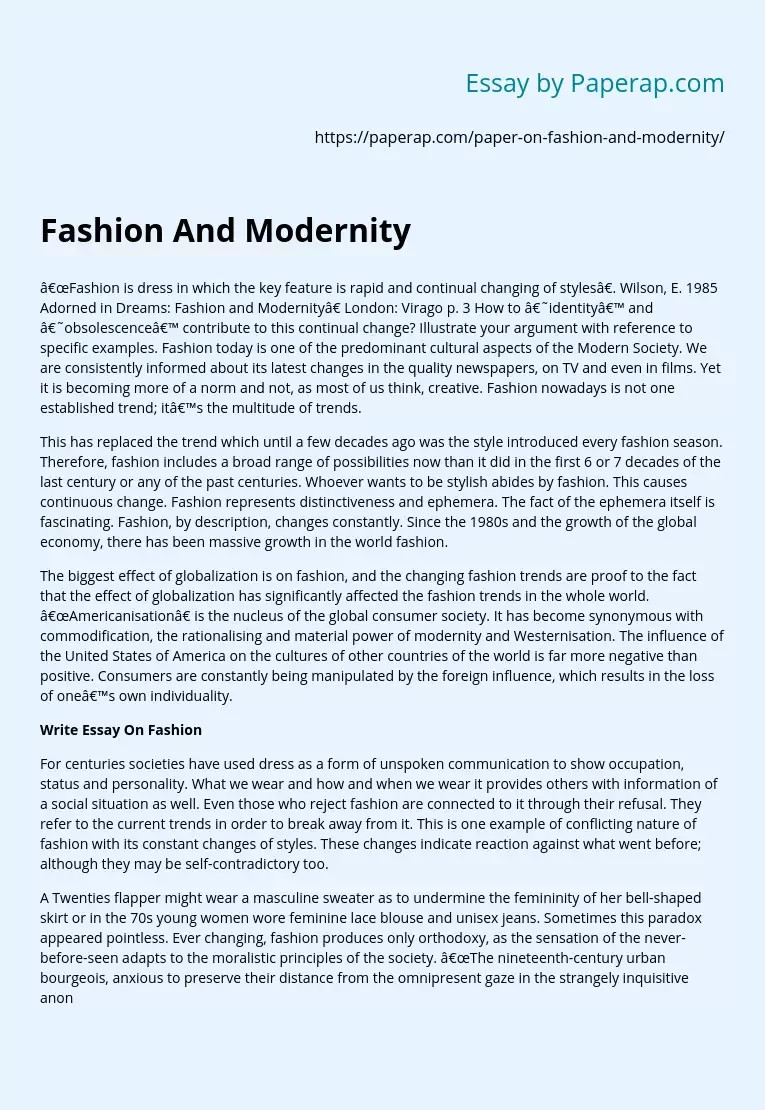Fashion And Modernity Phenomenon
“Fashion is dress in which the key feature is rapid and continual changing of styles”. Wilson, E. 1985 Adorned in Dreams: Fashion and Modernity” London: Virago p. 3 How to ‘identity’ and ‘obsolescence’ contribute to this continual change? Illustrate your argument with reference to specific examples. Fashion today is one of the predominant cultural aspects of the Modern Society. We are consistently informed about its latest changes in the quality newspapers, on TV and even in films. Yet it is becoming more of a norm and not, as most of us think, creative.
Fashion nowadays is not one established trend; it’s the multitude of trends.
This has replaced the trend which until a few decades ago was the style introduced every fashion season. Therefore, fashion includes a broad range of possibilities now than it did in the first 6 or 7 decades of the last century or any of the past centuries. Whoever wants to be stylish abides by fashion. This causes continuous change.
Fashion represents distinctiveness and ephemera. The fact of the ephemera itself is fascinating. Fashion, by description, changes constantly. Since the 1980s and the growth of the global economy, there has been massive growth in the world fashion.
The biggest effect of globalization is on fashion, and the changing fashion trends are proof to the fact that the effect of globalization has significantly affected the fashion trends in the whole world. “Americanisation” is the nucleus of the global consumer society. It has become synonymous with commodification, the rationalising and material power of modernity and Westernisation.
The influence of the United States of America on the cultures of other countries of the world is far more negative than positive. Consumers are constantly being manipulated by the foreign influence, which results in the loss of one’s own individuality.
History of Fashion
For centuries societies have used dress as a form of unspoken communication to show occupation, status and personality. What we wear and how and when we wear it provides others with information of a social situation as well. Even those who reject fashion are connected to it through their refusal. They refer to the current trends in order to break away from it. This is one example of conflicting nature of fashion with its constant changes of styles. These changes indicate reaction against what went before; although they may be self-contradictory too.
A Twenties flapper might wear a masculine sweater as to undermine the femininity of her bell-shaped skirt or in the 70s young women wore feminine lace blouse and unisex jeans. Sometimes this paradox appeared pointless. Ever changing, fashion produces only orthodoxy, as the sensation of the never-before-seen adapts to the moralistic principles of the society. “The nineteenth-century urban bourgeois, anxious to preserve their distance from the omnipresent gaze in the strangely inquisitive anonymity of the crowd where ‘anyone’ might see you, developed a discreet style of dress as a protection” (E.
wilson, 1985 p. 137) Fashion is a modern European occurrence, which is inseparable from capitalism in Europe. It is the progress of the bourgeois 19th century and the industrial revolution. Fashion can only flourish and become a mass event in an industrialized society with developed technology, sound aesthetic taste and uniqueness, as well as wealth. Because fashion is the opulence one must be able to pay for. ‘ Both haute couture and mass-production fashion were quick to adapt the youth cult to mainstream fashion. ‘ (E. wilson, 1985 p. 174).
Although today, in a time of mass production of cheap fashion for all, fashion becomes democratic. But this idea is misleading; even though everyone can be fashionable, fashion still plays the role of social distinction. But the decisive factor is not very emphasized; it shifted from the complete shape to details in preference in fabric and manufacturing. There are also factors such as the way of speaking and personal behavior that reflect social belonging. When dress was the only sign of status these factors weren’t as primary. Before fashion there was a traditional costume, or simply clothing. Clothing is the more broad term.
It stresses the functional roles, such as protection from cold, heat and other environmental factors. But costume did not only protect the human body, it decorated it too, which proves that the core role of fashion has always been to adorn human body. But the difference between fashion and clothing is that the clothing has a sound function. Whereas with fashion it is not enough; we need it to express ourselves to the visually obsessed society through the way we wear clothes, jewellery and body art. We need fashion because others approve it and we always change it because it becomes dull and stops to serve its purpose of being unique.
Fashion And Modernity Phenomenon. (2019, Dec 05). Retrieved from https://paperap.com/paper-on-fashion-and-modernity/

